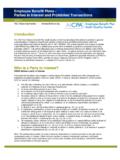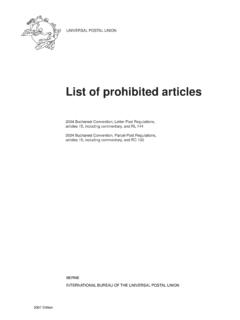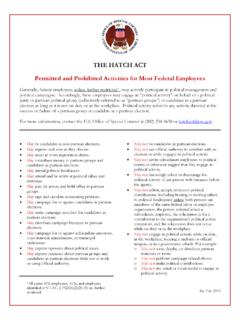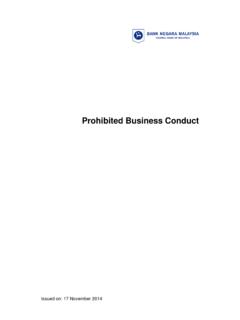Transcription of Change to definition of prohibited substances to be …
1 Change to definition of prohibited substances to be made in Greyhounds Australasia Rules Notice to trainers The definition of prohibited substance within GAR 1 is to be updated On 1 March 2018, Greyhounds Australasia will update the definition of a prohibited Substance within Greyhounds Australasia Rule 1. The aim of this Change is to provide a more detailed list of prohibited substance categories while also aligning the definition with other racing codes, which is important for cross-code regulatory bodies and the laboratories. Although the changes appear detailed, participants should be reassured that the Change in definition will not significantly Change the way laboratories conduct testing or report the detection of prohibited substances .
2 The definition of prohibited substance is largely unchanged in practice but is hopefully much easier for participants to understand and ensure they present their greyhounds free of prohibited substances on race day. The revised definition of prohibited substance' within GAR 1 is as follows: " prohibited substance" means a substance defined by the following criteria or which falls within any of the groups of substances declared herein unless it is an exempted substance. (a) substances capable at any time of causing either directly or indirectly an action or effect, or both an action and effect, within one or more of the following mammalian body systems: i. the nervous system ii. the cardiovascular system iii.
3 The respiratory system iv. the digestive system v. the musculo-skeletal system vi. the endocrine system vii. the urinary system viii. the reproductive system ix. the blood system x. the immune system (b) substances falling within, but not limited to, the following categories: i. acidifying agents ii. adrenergic blocking agents iii. adrenergic stimulants iv. agents affecting calcium and bone metabolism v. agents that directly or indirectly affect or manipulate gene expression vi. alcohols vii. alkalinising agents viii. anabolic agents ix. anaesthetic agents x. analgesics xi. antiangina agents xii. antianxiety agents xiii. antiarrhythmic agents xiv. anticholinergic agents xv. anticoagulants xvi.
4 Anticonvulsants xvii. antidepressants xviii. antiemetics xix. antifibrinolytic agents xx. antihistamines xxi. antihypertensive agents xxii. anti-inflammatory agents xxiii. antinauseants xxiv. antineoplastic agents xxv. antipsychotic agents xxvi. antipyretics xxvii. antirheumatoid agents xxviii. antispasmodic agents xxix. antithrombotic agents xxx. antitussive agents xxxi. blood coagulants xxxii. bronchodilators xxxiii. bronchospasm relaxants xxxiv. buffering agents xxxv. central nervous system stimulants xxxvi. cholinergic agents xxxvii. corticosteroids xxxviii. depressants xxxix. diuretics xl. erectile dysfunction agents xli. fibrinolytic agents xlii. haematopoietic agents xliii.
5 Haemostatic agents xliv. hormones (including trophic hormones) and their synthetic counterparts xlv. hypnotics xlvi. hypoglycaemic agents xlvii. hypolipidaemic agents xlviii. immunomodifiers xlix. masking agents l. muscle relaxants li. narcotic analgesics lii. neuromuscular agents liii. oxygen carriers liv. plasma volume expanders lv. respiratory stimulants lvi. sedatives lvii. stimulants lviii. sympathomimetic amines lix. tranquillisers lx. vasodilators lxi. vasopressor agents lxii. vitamins administered by injection (c) any substance administered to disguise or make undetectable, or attempt to disguise or make undetectable, the administration of any of the substance(s). referred to in paragraph (a) or (b).
6 (d) any substance(s) specified in Schedules 1 to 9 inclusive of the Standard for the Uniform Scheduling of Medicines and Poisons (Commonwealth) as amended from time to time. (e) unusual or abnormal amounts of an endogenous, environmental, dietary, or otherwise naturally present, substance;. (f) a metabolite, isomer or artefact of any of the substance(s) referred to in paragraphs (a), (b), (c) or (d) irrespective of whether or not such metabolite, isomer or artefact has any pharmacological effect;. In addition to the definition above, various thresholds exist for prohibited substances that occur naturally within a greyhound and are listed within GAR 83 (6) (12). These thresholds include testosterone, ethanol metabolites, hydrocortisone, 3-methoxytyramine, cobalt and arsenic.
7 Permanently banned prohibited substances are a type of prohibited substance listed within GAR 79A which are banned at all times and tested for in out of competition testing as well as standard race day swabbing. These substances must never be possessed, acquired, attempted to be acquired, administered or allowed to be administered to any greyhound from birth until retirement. prohibited substances can be possessed providing that is done so in accordance with GAR 84. and can be administered where reasonably indicated, but must not be detected in a sample taken when presented for an Event. Any use must be recorded in treatment records (GAR 84A). substances specified in Schedules 1 to 9 of the Standard are regularly updated by the federal Government and can be viewed here: susmp Table 1 below gives examples of specific prohibited substances that fall into each category listed within part b of the definition , but this list is not exhaustive and for clarification, participants should check with their veterinarian or controlling body before administering.
8 Table 1: Examples of prohibited substances described in Part b of the definition of prohibited substance ( Some examples given also fall within GAR 79A and are permanently banned prohibited substances . Again, participants should check with their veterinarian or controlling body before administering.). prohibited Substance Part B Examples Acidifying agents Ammonium chloride Adrenergic blocking agents Cyproterone, Metoprolol Adrenergic stimulants Adrenaline, Isoprenaline Agents affecting calcium and bone Calcitriol, Growth Hormone metabolism Agents that directly or indirectly affect Insulin Like Growth Factor 1, Darbepoetin alfa or manipulate gene expression Alcohols Alcohol, Methanol Alkalinising agents Sodium bicarbonate Anabolic agents Testosterone, Stanozolol, Methandriol, Nandrolone, Ethyloestrenol (males).
9 Anaesthetic agents Lignocaine, Bupivacaine, Procaine, Ketamine Analgesics Tramadol, Dipyrone (Metamizole). Anti-angina agents Amlodipine, Glyceryl trinitrate Anti-anxiety agents Diazepam, Alprazolam Anti-arrhythmic agents Atenolol, Sotalol, Lignocaine, Disopyramide Anticholinergic agents Dextromethorphan, Bupropion Anti-coagulants Heparin sodium, Rivaroxaban Anti-convulsants Clonazepam, Gabapentin Anti-depressants Clomipramine, Fluoxetine, Venlafaxine Anti-emetics Metoclopramide, Maropitant Anti-fibrinolytic agents Aminocaproic acid, Tranexamic acid Anti-histamines Chlorphenamine, Fexofenadine Anti-hypertensive agents Quinapril, Spironolactone Anti-inflammatory agents Carprofen, Meloxicam, Tolfenamic acid, Diclofenac, Flunixin, Ketoprofen, Piroxicam, Firocoxib, Phenylbutazone.
10 Corticosteroids Anti-nauseants Mirtazapine, Prochlorperazine Anti-neoplastic agents Letrozole, Medroxyprogesterone acetate Anti-psychotic agents Lithium carbonate, Risperidone Anti-pyretics Ketoprofen, Salicylates Anti-rheumatoid agents Sodium aurothiomalate, Methotrexate Anti-spasmodic agents Hyoscine, Propantheline Anti-thrombotic agents Prasugrel, Ticlopidine Anti-tussive agents Pholcodine, Acetylcysteine, Guaifenesin, Dextromethorphan Blood coagulants Aprotinin, Tranexamic acid Bronchodilators Salbutamol, Clenbuterol Bronchospasm relaxants Theophylline, Terbutaline Buffering agents Beta-alanine, Sodium bicarbonate Central nervous system stimulants Cocaine, Amphetamine, Methamphetamine, Caffeine, Theobromine, Benzylpiperazine Cholinergic agents Physostigmine, Pilocarpine Corticosteroids Dexamethasone, Methylprednisolone, Fludrocortisone, Prednisolone, Hydrocortisone Depressants Pentobarbitone, Alcohol, Cannabis, Arsenic Diuretics Frusemide, Hydrochlorothiazide, Spironolactone Erectile dysfunction agents Sildenafil citrate, Tadalafil Fibrinolytic agents Streptokinase, Tissue plasminogen activator Haematopoietic agents Cobalt, Cyanocobalamin, Ferumoxytol Haemostatic agents Aminocaproic acid, Tranexamic acid Hormones (including trophic hormones)




